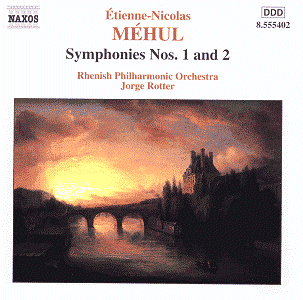
|
|||||||||
 |
|||||||||
Classical Editor: Rob Barnett Founder Len Mullenger: Len@musicweb-international.com
Etienne Nicolas MÉHUL (1763-1817)
Symphony No.1. in G Minor
Symphony No.2. in D
Rhenish Philharmonic Orchestra conducted by Jorge Rotter
Recorded Koblenz, January 1988
NAXOS 8.555402 [53.01]
Crotchet AmazonUK AmazonUS Amazon recommendations

Méhul was the leading French composer at the time of Napoleon and was mainly known for his operas. His music is seldom played in Britain now. However there has been a recent increase in interest in the music of contemporaries of Beethoven such as Fedinand Ries, Andreas Romberg, Ludwig Spohr and others which is much to be welcomed. Méhul completed four symphonies which were written around 1809. It is good to have a recording, at Naxos super-budget price, of the first two symphonies. The skill evident in these works was much appreciated by Beethoven (amongst others).
The first symphony opens in a style very typical of French orchestral music of that time with strong dramatic themes presented in full orchestration with emphatic use of percussion. These themes are developed in a style very reminiscent of Haydn and early Beethoven. There is a free flowing style movement with bold variations around an attractive tune which first appears on the strings. An interesting minuet and trio opens with an extended section featuring pizzicato strings. The work finishes with an exciting Allegro agitato which has touches which bring to mind the first movement of Beethoven's fifth symphony (which had only just been published).
Symphony No.2 opens with a slow introduction which again reminds one of Beethoven; the allegro which then unfolds again seems to have traces of Beethoven's Fifth Symphony. The slow movement opens with a flowing tune on horn and strings which subsequently has interesting contrapuntal treatment. The fast minuet movement in written in a free and often unusual way. Perhaps the most singular movement in this symphony is the opening of the last movement which is a drum solo from which is developed the principal theme which is used to form a dramatic and exciting finale.
Neither of these two symphonies reaches the very high standards set by Haydn, Beethoven or Schubert at their best (but how many works in the recorded repertoire do?). But nonetheless they are pleasant and musically interesting and far more than being of historical interest only. I have no doubt that purchasers of this disc will find themselves obtaining much pleasure from these two symphonies.
The works are well played by the Rhenish Philharmonic Orchestra under Jorge Rotter and the recording is good. The presentation is up to the normal high standard of Naxos and there are useful notes by Keith Anderson.
Overall this is a satisfying recording of two interesting symphonies from an unexpected source. It is fascinating to note that the recording was made over 13 years ago and this leads one to wonder what other fascinating recordings does Naxos have in its archives.
Arthur Baker
Return to Index |
||||||||
| Reviews from previous
months We welcome feedback on our reviews. Please use the Bulletin Board. Please paste in the first line of your comments the URL of the review to which you refer.This is the only part of MusicWeb for which you will have to register.
You can purchase CDs, tickets and musician's accessories and Save around 22% with these retailers: |
||||||||